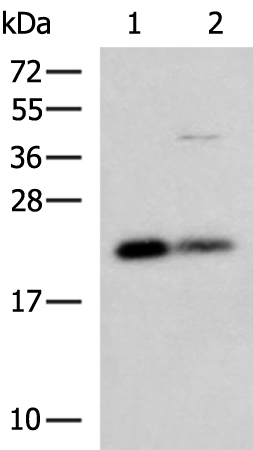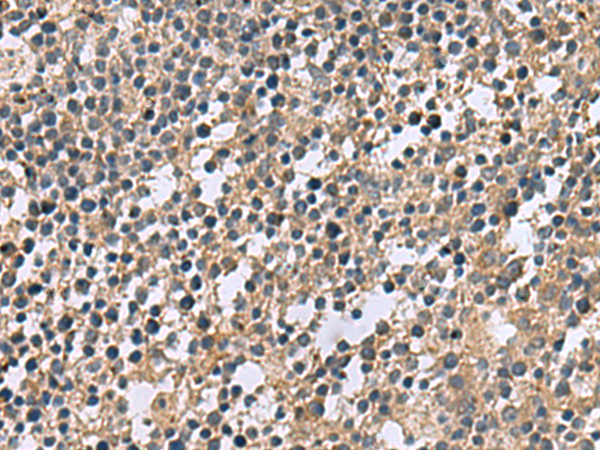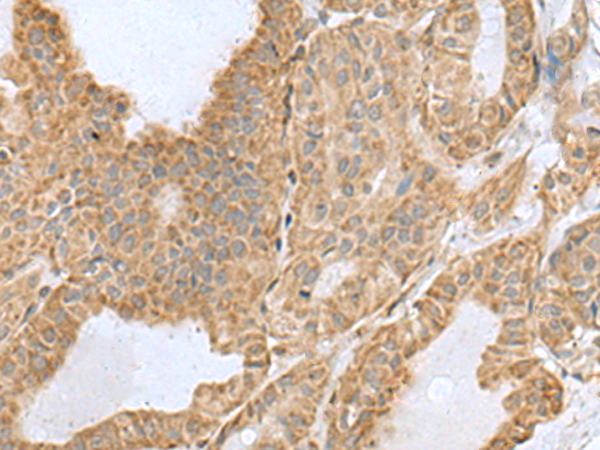


| WB | 咨询技术 | Human,Mouse,Rat |
| IF | 咨询技术 | Human,Mouse,Rat |
| IHC | 1/50-1/200 | Human,Mouse,Rat |
| ICC | 技术咨询 | Human,Mouse,Rat |
| FCM | 咨询技术 | Human,Mouse,Rat |
| Elisa | 1/5000-1/10000 | Human,Mouse,Rat |
| Aliases | CRP2; LMO5; SmLIM |
| WB Predicted band size | 21 kDa |
| Host/Isotype | Rabbit IgG |
| Antibody Type | Primary antibody |
| Storage | Store at 4°C short term. Aliquot and store at -20°C long term. Avoid freeze/thaw cycles. |
| Species Reactivity | Human, Mouse, Rat |
| Immunogen | Fusion protein of human CSRP2 |
| Formulation | Purified antibody in PBS with 0.05% sodium azide and 50% glycerol. |
+ +
以下是关于CSRP2抗体的3篇参考文献的简要概括:
1. **文献名称**: *CSRP2 regulates cell adhesion and migration in breast cancer*
**作者**: Wang Y, et al.
**摘要**: 该研究利用CSRP2抗体探究其在乳腺癌细胞中的功能,发现CSRP2通过调控细胞黏附相关基因(如Integrin β1)表达,促进肿瘤细胞迁移和侵袭,提示其作为潜在治疗靶点。
2. **文献名称**: *The role of CSRP2 in vascular smooth muscle cell differentiation*
**作者**: Smith J, et al.
**摘要**: 研究通过免疫组化和Western blot(使用CSRP2抗体)发现,CSRP2在血管平滑肌细胞分化中高表达,并通过与心肌素(Myocardin)协同作用调控收缩型表型基因的表达。
3. **文献名称**: *CSRP2 as a biomarker for hepatocellular carcinoma progression*
**作者**: Li X, et al.
**摘要**: 该研究通过免疫组织化学(CSRP2抗体)分析肝癌患者样本,发现CSRP2表达水平与肿瘤分期、转移显著相关,提示其可作为肝癌预后的生物标志物。
**备注**:以上文献为示例,实际文献需通过PubMed或Google Scholar检索确认。CSRP2抗体相关研究多聚焦于其在癌症、肌肉发育及纤维化疾病中的调控机制。
CSRP2 (Cysteine and Glycine-Rich Protein 2), also known as CRP2. is a member of the CSRP family characterized by LIM domains that mediate protein-protein interactions. It plays regulatory roles in cellular processes such as cytoskeletal organization, cell migration, differentiation, and tissue development, particularly in cardiac and skeletal muscle. Studies highlight its involvement in embryogenesis, with mouse models showing CSRP2 knockout leading to cardiovascular defects. Dysregulation of CSRP2 has been linked to cancer progression, fibrosis, and metabolic disorders, making it a focus in disease research.
CSRP2 antibodies are essential tools for detecting and quantifying CSRP2 expression in research. Commonly generated in hosts like rabbits or mice, these antibodies are validated for applications including Western blotting, immunohistochemistry, and immunofluorescence. They help elucidate CSRP2's subcellular localization (nuclear/cytoplasmic) and its interaction networks. Specificity is critical due to homology with other LIM-domain proteins (e.g., CSRP1/CSRP3), requiring rigorous validation to avoid cross-reactivity. In cancer studies, CSRP2 antibodies aid in exploring its dual roles—acting as a tumor suppressor or promoter depending on context—and its potential as a diagnostic biomarker or therapeutic target. Ongoing research continues to expand their utility in both basic and translational biomedical fields.
×